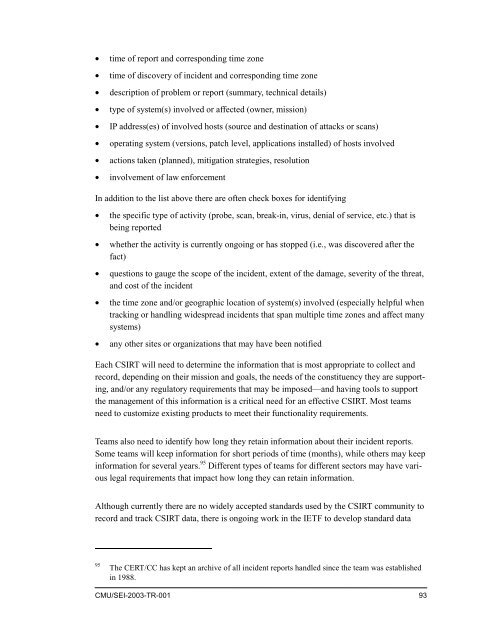State of the Practice of Computer Security Incident Response Teams ...
State of the Practice of Computer Security Incident Response Teams ...
State of the Practice of Computer Security Incident Response Teams ...
You also want an ePaper? Increase the reach of your titles
YUMPU automatically turns print PDFs into web optimized ePapers that Google loves.
• time <strong>of</strong> report and corresponding time zone<br />
• time <strong>of</strong> discovery <strong>of</strong> incident and corresponding time zone<br />
• description <strong>of</strong> problem or report (summary, technical details)<br />
• type <strong>of</strong> system(s) involved or affected (owner, mission)<br />
• IP address(es) <strong>of</strong> involved hosts (source and destination <strong>of</strong> attacks or scans)<br />
• operating system (versions, patch level, applications installed) <strong>of</strong> hosts involved<br />
• actions taken (planned), mitigation strategies, resolution<br />
• involvement <strong>of</strong> law enforcement<br />
In addition to <strong>the</strong> list above <strong>the</strong>re are <strong>of</strong>ten check boxes for identifying<br />
• <strong>the</strong> specific type <strong>of</strong> activity (probe, scan, break-in, virus, denial <strong>of</strong> service, etc.) that is<br />
being reported<br />
• whe<strong>the</strong>r <strong>the</strong> activity is currently ongoing or has stopped (i.e., was discovered after <strong>the</strong><br />
fact)<br />
• questions to gauge <strong>the</strong> scope <strong>of</strong> <strong>the</strong> incident, extent <strong>of</strong> <strong>the</strong> damage, severity <strong>of</strong> <strong>the</strong> threat,<br />
and cost <strong>of</strong> <strong>the</strong> incident<br />
• <strong>the</strong> time zone and/or geographic location <strong>of</strong> system(s) involved (especially helpful when<br />
tracking or handling widespread incidents that span multiple time zones and affect many<br />
systems)<br />
• any o<strong>the</strong>r sites or organizations that may have been notified<br />
Each CSIRT will need to determine <strong>the</strong> information that is most appropriate to collect and<br />
record, depending on <strong>the</strong>ir mission and goals, <strong>the</strong> needs <strong>of</strong> <strong>the</strong> constituency <strong>the</strong>y are supporting,<br />
and/or any regulatory requirements that may be imposed—and having tools to support<br />
<strong>the</strong> management <strong>of</strong> this information is a critical need for an effective CSIRT. Most teams<br />
need to customize existing products to meet <strong>the</strong>ir functionality requirements.<br />
<strong>Teams</strong> also need to identify how long <strong>the</strong>y retain information about <strong>the</strong>ir incident reports.<br />
Some teams will keep information for short periods <strong>of</strong> time (months), while o<strong>the</strong>rs may keep<br />
information for several years. 95 Different types <strong>of</strong> teams for different sectors may have various<br />
legal requirements that impact how long <strong>the</strong>y can retain information.<br />
Although currently <strong>the</strong>re are no widely accepted standards used by <strong>the</strong> CSIRT community to<br />
record and track CSIRT data, <strong>the</strong>re is ongoing work in <strong>the</strong> IETF to develop standard data<br />
95<br />
The CERT/CC has kept an archive <strong>of</strong> all incident reports handled since <strong>the</strong> team was established<br />
in 1988.<br />
CMU/SEI-2003-TR-001 93
















